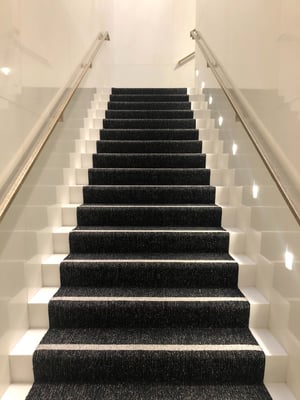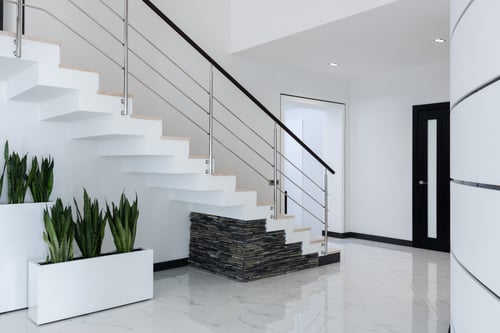Staircases tend to get overlooked during home renovations, which is a shame as they’re easy to upgrade and create a stunning statement feature.
There are lots of options for staircase renovations—from wholesale replacement to cosmetic retouches—many of which are more affordable than you’d think.
Staircase Renovation Basics
Stairs get a lot of use so the first priority is to address any structural issues and replace worn treads (horizontal part of the step) and risers (vertical). Depending on the age of your home, you may also need to add or update parts to comply with modern building and safety regulations.
After that, it’s all about the look. Your staircase is often the first thing people see when they walk in, and a shabby one creates a poor first impression. The good news is you can easily give this underappreciated area a lift with a new coat of paint, banister, balustrade or newel post. Any structural work must obviously be done by a specialist, but skilled DIYers should be able to replace things like railings and balustrades or clad steps, especially if buying a kit.
A professional installation takes around 2 days and you don’t need planning permission unless you live in a listed building.
Staircase Renovation Cost
Staircase renovation costs vary depending on the style, features, design and materials. A standard timber staircase will set you back £1,500-£3,000. A bespoke-design feature or complex structures like floating stairs, anywhere from £1500 to £20,000.

Staircase Renovation Ideas
Adding or renovating individual elements can have a huge impact on aesthetics. For example, fitting winding stairs instead of a square landing, adding a larger ‘curtail’ step at the bottom to create a hallway feature or swapping painted surfaces for natural wood.
Here are a few more popular staircase renovation ideas:
1. Glass Balustrades
Glass brightens up the stairwell by creating an illusion of space and allowing light to flow between floors. Open stairwells feature prominently in modern house design so this is a great way to update an older home too.
There are three basic design choices:
- Solid panels that slot into the handrail and base rail for a streamlined, continuous look.
- Stylish brass or brushed stainless steel clamps that separate glass from railings to add detail.
- Individual glass balusters that add detail with the play of light on chamfered edges.
Glass can be transparent or sandblasted to opaque or translucent; all work well with a range of materials, from elegant natural wood to ultra-modern brushed steel.
2. Banisters, Balusters and Spindles
These are easy to update and key to the look of your staircase. For example, replacing outdated solid panel balustrades or chunky ‘ranch style’ rails with spindles and a stylish banister really updates and opens up the space.
Old-fashioned, fiddly spindles that are a pain to maintain can also be swapped for elegant modern designs. The choices are endless, from classic turned shapes to tapers to square twisted, stop-chamfers and even curved ‘wave effect.’ Check out suppliers’ catalogues and talk to a home renovation planner to see what will suit the style of your home.
And in case you’re wondering what the difference is between a baluster and a spindle, it’s the width. A baluster is a row of balusters or spindles. You’re welcome.
3. Floating Stairs
This is a popular home renovation trend that really modernises and opens up the stairwell by fixing solid metal plates into the wall and laying steps on top. It’s a complex installation that requires welders and other professionals, though. A simpler, more affordable alternative is to simply remove risers to create an open tread staircase.

Staircase Renovation Steps
A relatively straightforward full staircase renovation involves:
- Stripping out carpet, treads, risers, banisters and balustrade.
- Checking the soundness of any remaining timbers.
- Installing new steps, in the case of a flat-pack. Pre-made staircase units are just slotted into place and attached to the wall.
- Cutting the base rail and handrail to the angle of your stairs before installation.
- Cutting the newel post and balusters or spindles to height and spacing out before fitting into base rail and handrail.
- Decorating and carpeting. Natural wood or white-painted steps are a classic but you can add colour with vintage-effect pastels, a bright patterned runner or by painting the wall a statement shade.
Tags:
Home RenovationJuly 28, 2023






Comments